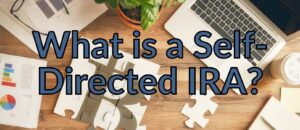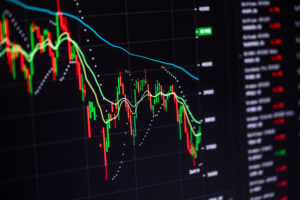
For many investors, the most optimal way to invest in digital assets is through their retirement account. There are huge tax advantages to investing in cryptocurrencies within a retirement account. However, digital assets are not offered within conventional individual retirement accounts. Instead, to invest in cryptocurrencies for retirement, you’ll need a self-directed retirement account for investing.
What is an SDIRA?
A self-directed individual retirement account (SDIRA) is a special type of retirement account that the account holder completely manages. Hence the term “self-directed.” Investors with an SDIRA can allocate capital to a much wider range of assets than in a traditional individual retirement account.
SDIRA vs. IRA
An SDIRA is similar to a conventional IRA in many ways. The tax and legal status of an SDIRA are the same as an individual retirement account as far as the IRS is concerned. Meaning, an SDIRA comes with the same tax benefits as its counterpart. But the most significant difference between the two is in terms of their investments offered.
Investment options
The major difference between the two is who decides which assets and types of investments are available within the account.
A conventional IRA has limitations on what assets can be invested within it. Depending on the financial firm that designed the IRA, some combination of stocks, bonds, mutual funds, and ETFs are available. You choose your investments based on the menu you’re handed. You can’t invest in assets that aren’t on the menu.
A self-directed IRA eliminates the menu-based investment selection. Instead, SDIRA holders can invest in a broader range of assets and so-called alternative asset classes. These include precious metals, commodities, real estate, private placement securities, digital currencies, and more. In addition, an SDIRA has access to stocks, bonds, mutual funds and ETFs. It just offers more choice.
Even so, an SDIRA doesn’t give you free rein to invest in anything you want. You still cannot invest in assets like collectibles, S-corporations, and life insurance through an SDIRA.
What is an SDIRA Custodian?
In order to protect the account holders of individual retirement accounts, the IRS requires that all such accounts be secured and managed by a custodian or a financial entity that holds and secures assets for safety and security purposes.
Unlike a financial planner or wealth manager, a custodian does not make financial recommendations but rather handles all of the paperwork and administrative responsibilities necessary for a retirement account.
The IRS outlines the role of a custodian for an SDIRA as follows:
“A self-directed IRA is an IRA held by a custodian that allows investment in a broader set of assets than is permitted by most IRA custodians. Custodians for self-directed IRAs disclaim most duties to investors. They may allow investors to invest retirement funds in “alternative assets” such as real estate, promissory notes, tax lien certificates, and private placement securities.”
Custodians are required for all SDIRA accounts, just as with any other type of retirement account. These custodians help account holders by:
- Recording income and assets within an SDIRA
- Tracking account contributions, transfers, and rollovers
- Processing all necessary tax documents and reporting to the IRS
- Completing trade and order requests as directed by the account holder
- Providing the account holder with regular account statements
Roth SDIRA vs. Traditional SDIRA
Tax implications
Contributions to a Traditional SDIRA are made with pre-tax dollars, meaning the contributions are subtracted from your income before taxes are calculated. As a result, any earnings on this pre-tax investment are taxed later, at the time of withdrawal.
Roth SDIRAs are the opposite: contributions are made with after-tax dollars. The benefit to a Roth is that any earnings within the account grow tax-free, which means withdrawals taken at the time of retirement are also tax-free.
Contribution limit
 A Traditional SDIRA has the same contribution limit, regardless of your income. See 2025 IRA and 401k contribution limits here. (For 2024, the contribution limit for a Traditional SDIRA was $7,000, or $8,000 for those aged 50 and older.)
A Traditional SDIRA has the same contribution limit, regardless of your income. See 2025 IRA and 401k contribution limits here. (For 2024, the contribution limit for a Traditional SDIRA was $7,000, or $8,000 for those aged 50 and older.)
However, Roth SDIRAs have a slightly different contribution limit schedule, which is tiered based on income for the given tax year. For instance, if you filed your taxes as a single person making more than the specified amount, your allowable contribution would be reduced.There’s also an income cap beyond which you’re simply not eligible to contribute to a Roth SDIRA at all. This is an important factor to consider, especially for high-income earners.
Early withdrawal
Because the money contributed to a Roth SDIRA is done after taxes, you can withdraw your contributions from a Roth SDIRA at any time without incurring a penalty. This is an advantage for those that may need access to this capital before retirement age (some think of Roth retirement funds as an emergency savings account).
A Traditional SDIRA only allows withdrawals starting at age 59 ½. Any withdrawals taken before that time come with a penalty.
Required minimum distributions (RMDs)
In a Traditional SDIRA, RMDs kick in at age 73. So, whether you like it or not, you will have to begin to withdraw capital from your SDIRA at that time. However, a Roth SDIRA has no RMDs, and therefore, you can continue to grow your capital within your account for as long as you want.
Risks
Fees
One of the drawbacks to an SDIRA is that this type of account can have fairly high fees. Along with management fees, there may be a fee to open an account, close an account, and even for making trades. As for the management fee structure, custodians may work from one of two models:
- Asset-based fee – This fee structure is based on the total value of all assets in your retirement account. Therefore, the fee you pay is directly correlated with any increase or decrease in your account value. An asset-based fee may be reassessed every month, quarter, or year depending on the custodian.
- Flat fee – A flat fee is the most simple fee structure available. In this model, you are charged a single, flat fee by your SDIRA custodian, regardless of your account value. This is advantageous for those who want a straightforward fee structure.
Liquidity
Alternative assets purchased within an SDIRA — such as real estate, precious metals, and commodities — may not be as liquid as traditional, electronically-traded assets. While the market for stocks, mutual funds, ETFs, etc., is readily available, allowing you to liquidate your positions at any time, this isn’t the case for some alternative assets in an SDIRA. (Investment real estate, for example, simply isn’t as quick to sell as shares of a stock or ETF.)
This could be a problem if an emergency arises and you need capital quickly. This could lead to selling an asset at a loss when ready cash becomes more important than profit.
Volatility

Alternative investments like cryptocurrencies can have higher volatility than conventional IRA assets like stocks and bonds. This volatility means that an SDIRA portfolio value can fluctuate on a day-to-day basis. A way to mitigate volatility is to invest in a diverse array of assets within your SDIRA. With this method, one volatile investment doesn’t cause a drastic change in value for the entire portfolio. According to Modern Portfolio Theory, a blend of diverse asset types lowers overall volatility and may increase returns.
Volatility is generally only an issue for investors with a short-term outlook. However, over a time horizon of at least a few years, an investment in cryptocurrencies should not be a concern.
Fraud
Fraud has unfortunately been more prevalent in SDIRAs than conventional retirement accounts. This is especially true in SDIRAs that invest in digital assets. The boom in initial coin offerings (ICOs) attracted many scams, putting investors at risk. According to the SEC, “Fraudsters may use the allure associated with ICOs and other digital assets to entice self-directed IRA investors with the promise of high returns.”
Many cryptocurrency IRA providers thoroughly vet their digital currency investment options before providing them as investment options. Here at BitIRA, we offer just 8 cryptocurrencies- none of which have ever faced any fraudulent SDIRA activities with shady individuals.
Following IRS guidelines
While an SDIRA brings with it the flexibility of alternative investments, this also presents its own risk for maintaining IRS guidelines. If you want to maintain the tax status of your SDIRA, you must be sure to follow all rules as laid out by the IRS. Some ways you might get your SDIRA status revoked are:
- Transacting with relatives
- Self-dealing
- Conducting a prohibited transaction (like selling property to your SDIRA)
- Borrowing against SDIRA assets
Digital assets in an SDIRA
The growth of digital assets (which is what the IRS calls cryptocurrencies) over the past decade has been unparalleled. Already a more than $1 trillion asset class, digital assets could provide a great alternative asset inside of a retirement account. But digital assets are still unavailable for investment in conventional IRAs and instead require the use of self-directed IRAs.
BitIRA is here to assist you in using an SDIRA for digital assets. Alongside its qualified custodian partners, Equity Trust Company and Preferred Trust Company, BitIRA offers a wide range of digital assets to choose from, including Bitcoin, Bitcoin Cash, Ethereum, Litecoin, and more.
Contact BitIRA today to learn how you can open your own SDIRA for digital asset investing.
